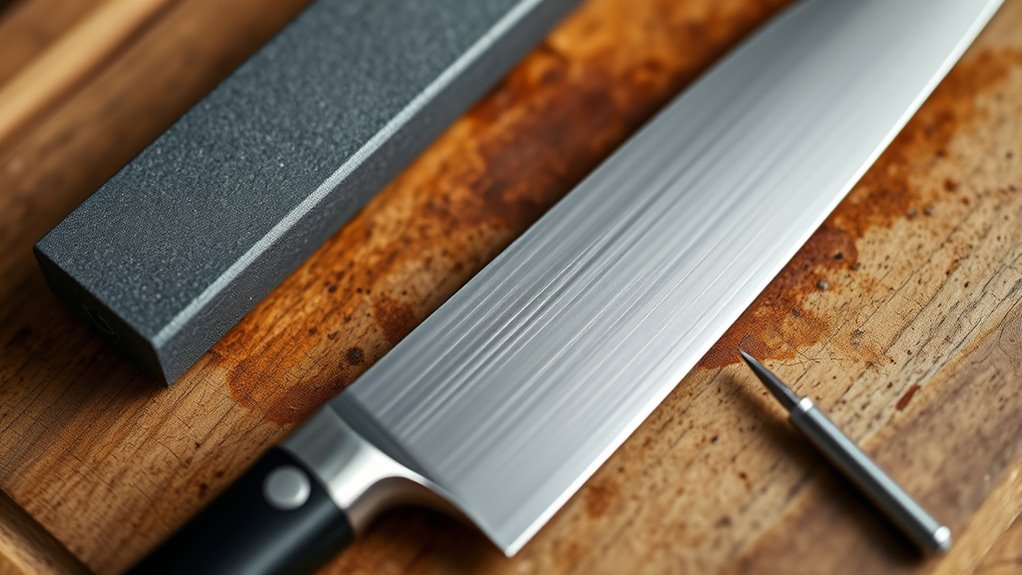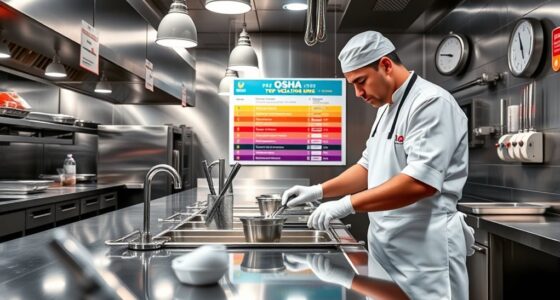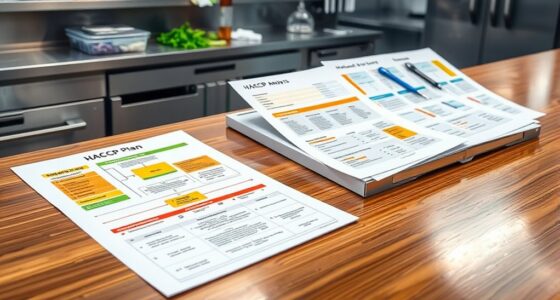To guarantee safe and effective knife use, always handle your knife with a secure grip, keep your fingers away from the blade, and use controlled, steady motions. Regularly hone your blades to maintain their sharpness, and sharpen them with proper tools like whetstones or electric sharpeners when needed. After sharpening, clean and store your knives properly to prevent damage. mastering these protocols will help you work confidently—continue exploring to become truly skilled in knife safety and maintenance.
Key Takeaways
- Always grip knives firmly with fingers away from the blade’s edge for safety.
- Use controlled, deliberate motions during cutting to prevent slips and accidents.
- Regularly hone blades at 15-20° angles to maintain proper edge alignment.
- Sharpen knives only as needed with appropriate tools, following manufacturer instructions.
- Clean and store knives properly after sharpening to preserve sharpness and ensure safety.

Keeping knives safe and sharp is vital for both your safety and efficiency in the kitchen. Proper knife handling starts with understanding how to hold and manipulate your blades correctly. Always grip the handle firmly, keeping your fingers away from the blade’s edge to prevent accidents. When chopping or slicing, use a controlled, steady motion rather than forcing the knife through ingredients. This reduces the risk of slips and injuries. Pay close attention to your cutting technique; a proper grip and controlled movements help maintain balance and precision, making your work safer and more efficient. Developing mindful cutting habits can further enhance safety and accuracy in your kitchen tasks.
Hold your knife firmly, keeping fingers safe, and use controlled cuts for safer, more precise cooking.
Using the right sharpening tools is essential for maintaining a sharp edge on your knives. There are various sharpening tools available, such as whetstones, honing rods, and electric sharpeners. Each has its advantages, but they all serve the purpose of restoring a blade’s sharpness. Whetstones require some skill but offer the most precise edge, while honing rods are great for realigning the blade’s edge between sharpenings. Electric sharpeners are quick and convenient but should be used carefully to avoid removing too much metal or damaging the blade. Whichever sharpening tool you choose, follow the manufacturer’s instructions closely to guarantee safe and effective use.
Regularly honing your knives keeps the edge aligned, which prolongs the need for more aggressive sharpening. Honing involves gently running the blade along a honing rod at the correct angle, typically between 15 to 20 degrees. This process straightens the microscopic teeth on the blade, maintaining its cutting power without removing significant material. However, honing doesn’t replace sharpening; it should be done frequently to keep your knives in top condition, with sharpening scheduled as needed based on dullness or performance decline.
When you do sharpen your knives, do so with patience and focus. Use consistent angles and gentle strokes to avoid uneven edges that can be unsafe and reduce cutting efficiency. After sharpening, clean your blades thoroughly to remove any metal filings, and always store knives properly to prevent dulling or damage. Proper knife handling combined with regular maintenance using appropriate sharpening tools greatly enhances safety and prolongs the lifespan of your knives. Remember, a sharp, well-maintained knife is safer and easier to control, making your cooking experience both safer and more enjoyable.
Frequently Asked Questions
What Types of Knives Require the Most Frequent Sharpening?
You’ll find that ceramic blades and knives with serrated edges require the most frequent sharpening. Ceramic blades tend to dull faster because their harder material loses sharpness quickly with use. Serrated knives, especially if used on hard foods or improperly, can also become dull or lose their effectiveness. Regular sharpening keeps these knives performing well, ensuring clean cuts and extending their lifespan.
How Often Should Commercial Kitchens Sharpen Their Knives?
In a busy commercial kitchen, your knives need frequent attention, just like your team’s coordination. You should sharpen your knives daily or every few days, depending on usage, to maintain ideal performance and safety. Regular knife maintenance involves using proper sharpening tools, such as whetstones or honing rods. This routine prevents dullness, reduces accidents, and ensures your knives stay sharp, reflecting the importance of consistent care in a bustling culinary environment.
Are There Specific Gloves Recommended for Safety During Sharpening?
You should wear protective gloves made from cut resistant materials during sharpening to guarantee safety. These gloves help prevent cuts if the blade slips, providing additional control and confidence. Opt for gloves specifically designed for knife handling, which are comfortable and durable. Always check that the gloves meet safety standards for cut resistance. Wearing the right protective gear minimizes injury risk and maintains a safe sharpening process.
Can Electric Sharpeners Damage High-Quality or Specialty Knives?
Electric sharpeners can pose risks to your high-quality knives, potentially causing damage if you’re not careful. The aggressive abrasive wheels may remove too much metal or alter the blade’s angle, risking irreversible harm. If you want to preserve your specialty knives, consider manual sharpening or professional services instead. Ignoring these risks might lead to costly repairs or replacements, so always prioritize gentle, precise methods to protect your investment.
What Are Signs a Knife Needs Sharpening Beyond Dullness?
You’ll notice your knife needs sharpening beyond dullness if you see edge burrs or uneven bevels. Burrs are tiny metal shards that create a rough feel along the edge, making cutting difficult. Uneven bevels cause the knife to slice inconsistently, often pulling or snagging on food. These signs indicate your blade’s edge is compromised, and sharpening will restore its precision and safety. Regular checks ensure your knife performs at its best.
Conclusion
By following proper safety and sharpening protocols, you reduce the risk of accidents and keep your knives in top condition. Curiously, some experts believe that regularly sharpening your knives actually makes them safer, as dull blades require more force and can slip. So, maintaining your knives isn’t just about performance—it’s about safety too. Stay vigilant, sharpen wisely, and you’ll enjoy a safer, more efficient cooking experience every time.








